Hello, Angie here! I'm a political science major trying to navigate (and hopefully survive) the enthralling and ensnaring political landscape.
Don't wanna be here? Send us removal request.
Text
Critical Essay 3: Araneta and MOA Arena As A Space Where Culture is Sold

(Image retrieved from: http://www.powcast.net/2015/10/la-salle-completed-come-from-behind-win.html)
The loud banging of the drums churning out the DLSU beats and the amazing energy you get from the crowd is utterly overwhelming. As Araneta and MOA Arena are where the basketball and volleyball games are held, once the UAAP season starts, they become my home every weekend.
Throughout my years as a cheerleader, I’ve been to all the games, minor and major, especially for basketball and volleyball. The one thing I’ve noticed is that whether someone is a Lasallian (or even a student belonging to any other school), they’ll come to the games to support the team they love most. I’ve witnessed people changing shirts from green to blue mid-game just because the blue side was winning.
Then, upon learning of cultural commodification and spaces where culture was being sold, it dawned on me: School’s cultures are sold every UAAP season. The hype and merchandise for school spirit reaches peak proportions every time there’s a major game, and people, Lasallian or not, lap up the merchandise and the culture, any chance to feel like a Lasallian.
They even partake in the alma matter at the end of the game, whether they know the lyrics or not, they raise their fists up high to become part of the Lasallian sea of green.
It’s interesting to note that this kind of culture commodification and selling has been around ever since the UAAP began. Also, this kind of culture-selling is not only confined to the UAAP season, but every time that someone even wears a shirt of a school that they’re not part of.
School cultures are being sold in Araneta and MOA Arena! People pay for the Lasallian exprience and to partake in that culture, as well as to be a Lasallian for a day.
So the next time that you’re in Araneta or MOA Arena for a DLSU game, take note of the cultural commodification and selling that takes place around you. Ask yourself, am I part of this commodification? And if you are, there’s nothing wrong with it. We now live in a time where even cultures can be bought and sold.
Indeed, hail hail to the alma matter, my fellow Lasallians.
0 notes
Text
Critical Essay 2: Avatar, The Last Airbender

(Image retrieved from: http://www.zerochan.net/Aang)
Avatar: The Last Airbender tells the story of Aang, the avatar who hasn’t been seen in a hundred years. Upon waking up from an iceberg that he had been frozen in, he finds out the world he was supposed to protect and save has been caught in a hundred year war between the Fire nation, and all the other nations (Earth, Water, and Air, but the Air nation had been the first to be completely eliminated by the Fire nation) trying to defend their respective territories from the Fire nation’s attacks.
Being a part of the Air nation, Aang seeks to return to his people, only to find out that he has no more people. Aang’s nation has been completely eradicated by the Fire nation, and thus, Aang is the only airbender left in the world. His people had been victims of genocide at the hands of the Fire nation.
This show (which is actually a cartoon, but when further analyzed from a political lens, each nation and character is shown to fight for a certain ideology that ultimately leads to either their downfall or survival in the hundred year war. So, let’s get right down to it!
First, let’s tackle the Fire nation, the antagonist in the whole series. Their claim to power is to “unite” all nations under one totalitarian dictatorship led by none other than the firelord. Their ideology is based on the fact that their nation alone is the only one fit to rule because they see their element, fire, as the most powerful one that can bring all the other nations down to bend the knee.
Second, the Air nation. The Air nation is represented through flashbacks, and their genocide was also shown in the series. The Air nation was so easily eliminated because the ideology they believed in was one of peace and passiveness. Once the war started, they decided that their standpoint was that they would not join the war at all, avoiding violence and bloodshed at all costs, as this was not their way of life (their way of life follows that of Buddhist monks). This made them an easy target for the fire nation to exact their cultural genocide towards the airbenders, ultimately leading to their demise both as a nation and as a culture.
Third, the Earth nation. The Earth nation is steadfast, strong, but also stubborn. People from the earth nation are courageous, but their stubborn ways is their weakness, yet they have survived great attacks from the fire nation and have managed to protect their territory from being invaded during the hundred year war. Their ideology is similar to the fire nation, minus the war tendencies. Their ideology represents a military dictatorship, as the Earth queen has an elite team called the Dai Li, the nation’s top earthbenders that do surveillance on all of its citizens, ensuring their discipline and compliance to all of the Earth Queen’s wishes. This dictatorship comes through the form of monarchy and garners power by respect for the crown. Despite the people seeing the Earth Queen’s erratic tendencies, sometimes to the point of madness, she still has loyal subjects that follow her blindly simply because they have been under the form of monarchy ever since their nation was established, and their respect for the crown keeps them loyal to their Queen, even if she’s gone mad.
Lastly, the Water nation. The water nation’s ideology is fluid and flexible, but not motivated. Their form of government is that of a tribe with a selected set of leaders. They have only managed to barely survive the war, losing many men, women, and even children in the process as they get taken away by fire nation soldiers to work in their concentration camps.
All in all, all nations have differing narratives that dictate where they currently stand in the war. Each narrative shows an ideology that brought each of them down. The airenders are free-spirited, but distanced and detached from the world, and their nomadic and loose nature allowed them to be wiped out so easily. The waterbenders are flexible but not motivated, their go with the flow attitude allowed their tribes to get picked off one by one. The earthbenders are firm but unchanging and rigid in their ways, and their adamancy led to a steely military dictatorship that kept a perpetual illusion of peace. The firebenders are passionate and determined in their cause to unite and rule, but at the price of obsession and psychopathy; what started as a plan to “illuminate” the world with their flame lapsed quickly into pure destruction.
Their narratives each explain their rise and downfall as a society, and from the way they stuck with and followed their ideologies set about and propagated by their leaders, we can learn about the dangers of ideologies and how it can affect not just one nation, but the whole world in its entire totality.
Despite this being a cartoon, it is the prime example for showcasing the dangers of ideologies, and what happens when one takes the passion into the threshold of psychopathy.
0 notes
Text
Critical Commentary 3: Oh Filipino, Filipino, Filipino
(Reposted due to loss of first blog)

(Image retrieved from: https://www.hoppler.com.ph/blog/real-estate-moving-and-relocating-tips/things-to-know-before-working-in-the-philippines)
One of the most extensive (and undoubtedly one of the most repeated) things we learn in Filipino history is the loooooooong time we spent under Spanish rule, only to be semi-”freed” and given to America, where we never fully recovered our national identity. Often referred to as three-hundred years in the convent, the Spanish colonization period has changed the course of our nation’s history and identity forever.
It was discussed in the last entry how the major obstacle after colonial overwrought is the formation of a national identity. And while a colony can spend all of its power and might to regain and reform their national identities, it makes it extremely more difficult when the colonized barely had their own identities before the colonization period began.
As a Filipino citizen that has learned a considerable amount regarding our history and our never-ending quest for identity-formation, I can say with pure confidence that we have yet to regain the identity that was shattered to snippets during those long years in the convent. There are various historians that argue that since we are an archipelago made up of thousands of islands, each with its own identity, we never had a collective national identity to begin with. Sadly, our collective experience under colonization became one of the first things that the entire nation shared and partook in.
Putting narratives into play here, very little areas of the Philippines were left alone or not fully conquered during the colonization period, and their narrative presents a counter to the colonial narrative that the rest of the country experienced at the time.
But, there is a positive side to our colonization. The disciplines and practices from the West strengthened our narratives by allowing us to be conscious of our lack of shared identity, as well as the use of these Western techniques to be adjusted so that the focal point is on us; our socialization, our narratives, the Filipino experience all in all. From this, Filipinos were able to create their own narrative using psychology. Filipinos adjusted to the Filipino contextualizations and used to investigate and analyze our forms of interaction and shared close-knit familial perception on many things. This was termed as Sikolohiyang Pilipino.
Another one that gave our narratives power is Pilinohiya, which focused on certain principles and values that were unique to the Filipino culture. While Panatayong Pananaw discusses the Filipino way of discourse, and because of the Filipino ways and culture being the focal point of this psychological analysis, our shared identities were given light, power, and importance. True enough, there was a Filipino way, we shared common values and principles, things that made us distinctly Filipino.
Despite all those years in the convent followed by more years under Uncle Sam, the Filipino spirit pushed through, and ironically, thanks to Western influences and disciplines, our country is on the road to structuring our own Filipino narrative and our national identity.
0 notes
Text
Critical Commentary 2: Post-colonial Theory, the aftermath
(Reposted due to loss of first blog)
Throughout the history of the world, a majority of states have either been colonized, or were the colonizers themselves. There are many reasons as to why a powerful nation would choose to exalt its men and resources to a faraway land. European nations that turned to colonization seized lands many miles away from them for reasons such as taking hold of the abundant resources to be found on that land (many of which they don’t have on their own), to spread their own ideologies and belief (whether it be their religion or their way of governing), to further their own culture and have it reign supreme, to usurp these lands from their previous leaders for monetary gain (Spain did do it for God, Gold, and Glory!), or a combination of all these things.

(Image retrieved from: https://onworldliterature.wordpress.com/2014/08/06/what-is-postcolonialism/_)
But, the colonized are the ones that suffer greatly from these endeavours. For even if in the eyes of these Western colonizers the colonized collective were “savages” that needed to be “humanized” and groomed for civil society, much of the colonized collective’s culture, civil structure, and identity is now forever damaged and hampered by the Western endeavours to supposedly civilize.
The massive obstacle that nations that have previously been colonized face is the destroyed identity and culture of their society. Due to extensive efforts to “civilize” and to assimilate the colonizer’s culture and identity into that of the colonized’s society has greatly hampered any profound development in their respective identity. Their identity has been malformed during the colonial experience. An entire country’s shared identity is destroyed (either wholly or in great amounts), and their history, language, culture, and customs that were in place before the colonization is demolished into smattering snippets. The assimilation and extensive reorientation of identity done by the colonizers is distorted, extremely revised, and ultimately not their own.

(Image retrieved from: http://www.hizb-australia.org/2017/06/the-history-of-colonialism-a-brief-explainer/)
Post-colonial theories are entwined around the collective struggle of the colonized to rebuild what has been dismantled time and time again, over an expanse of years that have left a scar on their country. In Edward Said’s The Orient, he speaks about the othering process done by colonizers to make the colonized outsiders in their very own land. To be the other means to be on the bad end of the binary opposites that he discusses. In the quest of the aforementioned endeavours of the colonizers done under the guise of “civilizing the uncivilized,” the othering is still felt up to this day, even when the colonizers have long gone from the colonized lands.
Theories on post-colonialism are honourable theories in the discipline of political science as they serve as guides in understanding not only the collective trauma of the colonized, but also the endeavours that led to the extensive and wrongful “civilizing” quest of the colonizers. In studying this shared trauma, we are enabled to understand how it affected the identity formation of both the individual and the society, as well as examining the national identity and culture of the colonized. The last rebellious act that the colonized can do to give a giant middle finger to their colonizers is rectify itself, reform and restructure its shared identity, and remember the horrors of the past so that they may learn and use it as a reminder for why they must continue on repairing what was destroyed.
0 notes
Text
Feminism: Don’t Judge Me By My Vagina
(Reposted due to loss of first blog)

(Image retrieved from: https://www.neatoshop.com/product/Girl-Power-3)
As a little extra reading for the theory of feminism (something that I’m extremely passionate about and interested in), I read Deborah L. Rhode’s The Ideology and Biology of Gender Difference.
As Rhode states in the opening paragraph of her analysis of gender difference “In every known society, gender differences structure human identity and social relationships.” From the very moment you are born, a certain human identity and specified ideology to match your biological body parts has already been placed on you. In less progressive times, to stray away from your assigned human identity would induce social stratification, and often times reclusion from society. This was the kind of ideology I grew up with, however, kudos to my parents, they have adapted new perspectives on gender identities over time.
As Rhode says in her analysis, from a very young age, we are put under “sex appropriate” socialization (skirts and dolls for girls; guns and pants for boys). However, when I was growing up, my parents let me pick my own outfits, let me choose the sports I wanted to tackle, and never did they once limit me to any activity just because of my gender. I was more than welcome to wear pants and cargo shorts, I was allowed to take up taekwondo and football, and I was also welcomed to partake in all the things that girls enjoyed such as Polly Pockets and glittery headbands. The way I was raised combined with the non-exposure to gender limiting has had an immense effect on how I now define gender. I strongly believe that no man or woman should be judged according to their gender, but how they present themselves and their capabilities and skills. To me, your biological parts should never be a hinderance to what you want to achieve, and it both astonishes and angers me that others hold such a backwards view on gender limitations based on biological characteristics.
The assumption being that everyone, regardless of what they identify as, deserves respect, because respect is a basic human necessity that everyone needs in order to function. Our discussions have also opened my eyes to the different biases someone can have just because of someone’s manhood or womanhood. All in all, and to be quite frank, no one should be judged just because of what they have between their legs.
0 notes
Text
Critical Commentary 1: The Political is Personal, and the Personal is Political
(Reposted due to loss of first blog)
In all of my political science majors, they all say that political science is all about power and the institutions and processes that give both the state and individuals that power, along with how its distributed. When going over the past theories learned, they fully support that statement that runs as one of the very core tenets of political science as a discipline.
Our chosen field puts serious value to analysis of power, institutions, processes, and the state in order to better scrutinize the political phenomena. Because of this great import political science puts on the aforementioned, it has traversed through the road of becoming a scientific discipline, and it has been greatly helped by the many efforts of political scientists over the years. Thanks in great part to their endeavour to conduct their work in a way that resembles the scientific method, meaning that their theories are backed up by empirical data, it is systematic in nature, and the procedure can be both recreated and adjusted to test out varying situations.

(Image retrieved from: https://www.pinterest.com/bdelorian0173/political-animals/?lp=true)
With the approach of political scientists being transformed into one that resembles that in the field of science, political science greatly differs from what it once was. Looking back at the theoretical antecedents, those theorists focused on the collective, on the state formation, but not much on the individual, yet as a different era began anew, so did the focus of the theories that arose to explain political phenomena.
The theories made by those dead white Western men were expository in nature, meaning that had they not generated the theories that they produced, both the world and the knowledge we have on power struggle and dominance would be very forever changed.
These controversial theorists and thinkers took a chance on their work and saw it as something worth followiing. It takes a special mind to see the social order for what it truly does to each class, and even more so to question it. I view these theorists as the puppets who cut themselves free of their own strings so that they could dance their way to the back to analyze who the real puppet master is.
Savants such as Karl Marx (who clearly saw the class struggles and the oppression of the working class but did not foresee the brilliant adjustment of the capitalists to prevent a socialist revolution), Antonio Gramsci (who continued on and was heavily influenced by the work of Marx and to go on to define hegemony through culture and ideology and how this may be used as a weaponized tool for control and domination), and the Frankfurt School (with theorists that defiined reification and how it creates more domination and control over the working class, and the subject-object relationships that allow for easy dominion over the people objectified as such).
After these savants had paved the way for this line of discussion during the modern era, the era of post-modernity came anew and gave way for new intellectuals to rise to the occasion. The post-modern era brings along new theories to revamp the limited and weakening theories from the modern era.
Modern-era theories were still used as a model and influenced the post-modern theories, but with an adjustment in the focal point and outlook. Postmodernism shone light on the fact that the passive, the invisible, and the private were essential to better understand the self, and in relation, the political. In delving into the subjectivity that is the self, the expression of the individual is put in a critical light, and thus, so is the political. After all, man is a political animal, and politics is everywhere.
The combination of the theories from the modern and post-modern eras have enabled today’s political scientists to take into account the narrative of both the individual and the collective. This new work has led to better understanding about the self, and how the self is intertwined with the institutions, the structures, the processes, the power! Through the more thorough cognizance of the self, political scientists are able to understand the formations of identity, how certain ideologies have domineering impacts, the creation of social classes, personal narratives that make up the metanarratives, and the implications of those narratives on the structuring of the individual and the society.

(Image retrieved from: https://autodo.info/pages/s/self-realization/)
There is a reason that these theories are studied in political science. Not only do they serve to explain the collective political phenomena, but they provide a fresh lens with which to be critical of the self and its relation to the political collective. In using these theories to understand the self and our innate political animal, one can get a better understanding of the political in return.
0 notes
Text
Post-Modern Theory: The Rise of the New
(Reposted due to loss of first blog)
The period of modernity (which lasted nearly a century) contained science establishing facts properly, and it also contained the establishment of the social state with regards to political theory. This was a period dominated by the theory and thoughts of Marx, and those that his work influenced. Yet, as is the nature of all things, the period of modernity thus passed and was followed by the era of post-modern theory.

(Image retrieved from: http://lstallardpsychotherapy.blogspot.com/2012/06/postmodern-counseling-theory.html)
If the era of modernity lasted for nearly a century, we are still experiencing post modernism until this very day as it started in 1980, and is still considered to be ongoing up until present time. While the modern period was characterized by the establishment of the social state, the post-modern era is characterized by the rise of the nation-state disputed by new theories, also known as post-modern theories such as feminism, environmentalism, and the work done by Baudrillard, Foucault, and Lyotard.
Baudrillard, Foucault, and Lyotard gave us new perspectives that beautifully continued the work done by the political frontrunners discussed in my last entry on Theoretical Antecedents.
To contemplate on Baudrillard’s philosophy, he views society as a portioned locale of personal incidences and human notions, and that reality is still subjected to human thought. As humans, we are the ones to perceive our own reality, no matter what kind of ideology we partake in or the kind of narrative we dwell in. Baudrillard put emphasis on the fact that language, texts, and culture may come to light as quiescent, the language, texts, and culture that we are surrounded by greatly influences how people in society live out their lives, as well as their interactions with other members within that society.
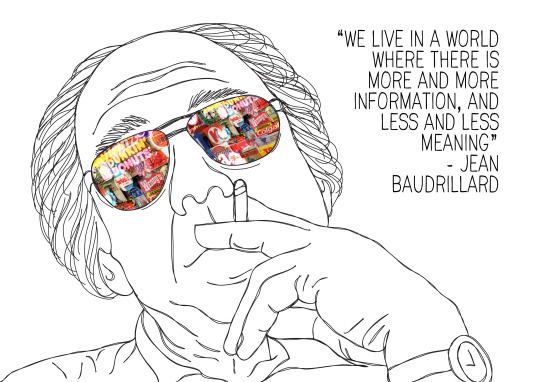
(Image retrieved from: https://taylornicolesim.wordpress.com/category/theory/)
If the era of modernity had Marx, the era of post-modernity was gifted with Baudrillard. “His notions of the simulation society and hyperreality provide a foundation for a lot of postmodern cultural studies,” (Contreras, 2017). Baudrillard’s arguments, as well as the rise of the post-modern era, should aid an individual in this lesson: take note of how you participate in the daily simulations that Baudrillard speaks of. The daily elements in our lives such as the very language we use to communicate, the publicizations surrounding us (whether we like it or not), these very things that we see each and every day are all possible weaponized tools for control. Without self-awareness as well as awareness on the very core of our individuality and to be constantly critical and vigilant on our own individuality, the simulations Baudillard speaks of can eat us up and absorb us into conformity.
Another notable forward thinker that the post-modern era has been gifted with is Michel Foucault, a philosopher and post-modernist (of course). Instead of outside and strict restrictions, Foucault went with analyzing the connection “between power and discourse in ‘disciplinary society’,” (Contreras, 2017). He propagated that through proper contextualization, examination, and genuine discourse of issues his idea of the desired society may be actualized. His perspective led to a more analytical and psychological embarkment on the possible solutions to societal issues, which were previously put away as issues that could only be reconciled and straightened out through brutality and penalization. Foucault’s work with prison systems and the reinvention of their treatment and nature of their reinforcement is still extremely relevant today as it is a far better compassionate decision than the former ways of barbarity within the prison system.
Lastly, we explore the work of Lyotard. His work is worth noting as he delves into the role of narratives and texts as possible sources for oppression. Lyotard investigated how narratives and the human experience affect the simulations (the ones pointed out by Baudillard) and the thought process of not just an individual, but the collective as well.
All in all, the era of post-modernity allowed for the birth of theories that analyze both the personal and cultural distinctions of the society. The post-modern theories also attempt to explain how these personal and cultural distinctions conduct the dominance, control, and skewness of power within the society. The work done by the three notable theorists propound that there is another way for power to gain mobility, and that is through the undetectable and the seemingly quiescent elements of our daily lives (such as the language, or the advertisements we are bombarded with).
Yet again, this lesson on post-modern theories teaches the individual to remain a critical individual, as well as to remain utterly critical on our individuality. We must stay attentive towards the formation of our character and if our ‘self’ has been breached by the various dominions that aim to dominate, control, and deviate our self-power.
0 notes
Text
From the Other Side of the Spectrum
(Reposted due to loss of first blog)
In exploring queer theory, I’d like to share an experience from my GENDERS class last term where in we had Queer Day. Our class was given a day where in we would dress as a gender that was not ours. Take note here that our professor never said “come to class dress as the opposite gender,” because we spent the entire term learning that gender is not like a door with only two sides, but it is instead a whole spectrum of genders that people choose to identify with. My experience during Queer Day was amazing, because instead of just seeing guys dressed as girls and vice versa, people came in full on drag costumes, both drag kings and drag queens (my friends and I decided to go for drag kings as well). The following details my reflections and the events of what went down on Queer Day.
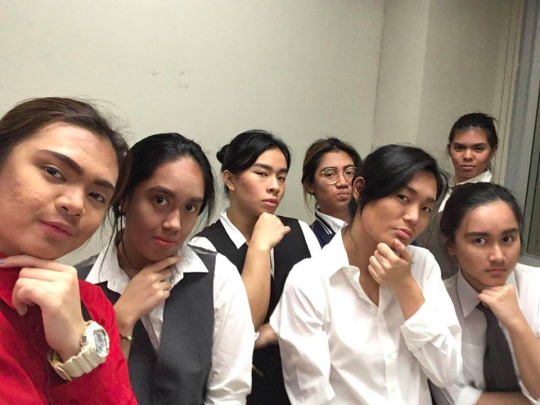
As I asked my boyfriend if I could borrow some of his clothes for queer day, he gave me an inquisitive look and asked “You’re going as a boy? Shouldn’t you be gay or something?” And that’s the moment when I realized how important it really was to not only have Queer Day, but to also be properly educated on the subject of Genders, even if it’s just a general view. I wanted to tell him that he should go with me to Queer Day and learn a thing or two about the wonderful and rainbow-colored spectrum of queer, because the freedom to identify in any part of the spectrum is exhilarating, but I decided that he would have to learn all this for another time. Instead, I borrowed his pants, a vest from his three-piece suit, and got my makeup to contour like a drag king ready to serve up some realness.
When I got to the classroom, everyone was getting ready to change into the costumes they had prepared for the day, and it was extremely nice to see that instead of hesitant faces, a lot of people were excited to showcase what they had prepared for the day. Not only that, but you could really see from the presentations that people did not half-ass their costume, with some even going all out for drag with wigs and spot on contour, to boys that weren’t afraid to show some skin with their spaghetti strap dresses.
Once the presentations began and everyone explained, or performed, what queer was for each of them, I began to understand the term ‘queer’ even further and connected it to Jagose’s Queer Theory. Specifically in chapter 7, when he wrote that queer is an umbrella term that encompasses a lot of people non-specific to sexual orientation and gender. The representations of queer that day ranged from every inch of the spectrum that queer represents. While some opted for the traditional cross-dressing variety of performance, there were drag kings, drag queens, a street culture kind of queer, and a fierce fashion show of men and women feeling comfortable in the clothes of the opposite sex. Basically, for Queer Day, we were comfortable with being another gender identity for the day, and a lot of us really enjoyed the experience of being able to openly dress like any gender identity on the broad spectrum of queer that Jagose discusses in his work on Queer Theory.
According to Jagose, “the term ‘Queer’ emerged from the growing awareness of the limitations of identity categories in terms of personal identification.” What was once thought to be a derogatory term (Queer used to mean strange, odd, freaky, unnatural) had undergone a metamorphosis to transform into what we now know queer was. Judging from the various definitions given by the class on Queer Day, none of it connoted what queer used to mean, but instead, queer has become a positive term that encapsulates freedom of self-expression and non-conforming fluidity. The term queer has transformed over the years to become one of power, of a definite but non-definitive term for people who are not exactly sure on what side of the spectrum they lie on, but don’t identify with the traditional gender identities that have been set out.

(Image retrieved from: http://mapabing.org/2017/03/02/queer-theory-and-archaeology/)
Aside from showing the free-ranging classifications that ?exist outside the traditional representational frames,” Queer Day put each individual in the shoes (some quite literally, as others really did use the shoes that fit their Queer Day costume) of another gender. As Judith Butler said “Gender is the repeated stylization of the body, a set of repeated acts within a highly rigid regulatory frame that congeal over time to produce the appearance of a natural sort of being.” Every person that participated in Queer Day got to restrict themselves to this highly rigid regulatory frame with their ‘repeated acts’ that befit the gender they were trying to go for that day. Guys had to move sparingly due to their short skirts and dresses, girls had to lower their voices and walk the way a guy would, and those that were in drag had to come out of their usually reserved selves and, as Ru Paul would say, “Sissy that walk.” These little repeated acts that we did naturally when we were our original selves had to change as we took on the challenge of portraying someone completely different from us, and it was extremely fun.
All in all, Queer Day was a nice closer for a whole term’s worth of education on genders. It proved to be a great practical application on how the other gender feels, and how we can have fun with what we learned. However, the most important thing about Queer Day was that it taught each individual what it felt like from the perspective of the other genders, something that isn’t exactly easy especially if your environment is not the most accepting or welcoming one. Yet, the environment in that class was one of positive reception, coming from both the professor and the class. In conclusion, Queer Day was a smashing way to end the class and take out the concepts we’ve learned and turn them into fierce queer realness.
0 notes
Text
Theoretical Antecedents: Hey MTV! Welcome to My Commodified Culture
(Reposted due to loss of first blog)

(Image retrieved from: http://www.funnyordie.com/articles/687e76f2e3/unnecessary-tribute-episodes-of-mtv-cribs-that-enlightened-a-generation)
Pop culture, viral fads, all the trends. These are the results of a culture commodified. Hey MTV, and welcome to my commodified culture.
Wherever we see pop culture, the latest trends, or the craziest viral videos, photos, or fads, this is where we see the work of the culture industry. These are multiple industries combined (e.g. mass media and entertainment) that have worked rigorously for decades to mass-produce cultural commodities and utilize these as a tool to spread their control and manipulation over the minds of the masses. In all honesty, it’s purely genius.
Popular culture has amassed such a large following (especially since it gives a sense of belonging and oneness to those who partake in it) that it’s everywhere. Pop culture is easily manipulated by the media, influenced by those in power, and has such a far reach that one thing originating from a country millions of miles away from us can still go viral in our own country.
But how does popular culture manipulate people’s consciousness in the first place?
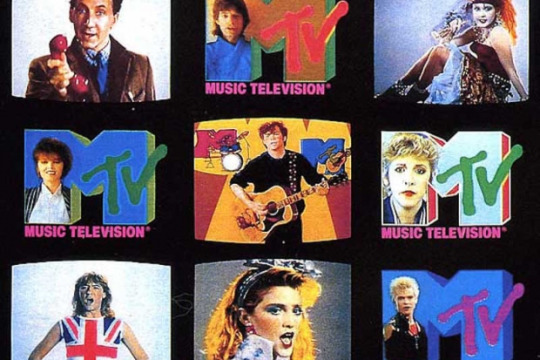
(Image retrieved from: https://www.hercampus.com/school/ufl/5-mtv-videos-80s-every-millennial-should-watch)
According to Marcuse, culture has become affirmative. Through this transformation, the culture industry has produced a drug to distract. This culture drug turns people’s attention from their realities and the problems within it by making the reality out to be satisfactory. Marcuse goes further to say that pop culture has is one-dimensional in the sense that it faces no opposition, this is supposedly the only one true shared culture we have, and it is not a place where critical ideas gather to be posted and shared with the world. The affirmative nature further strengthens the ideological and cultural manipulation on the masses; it has metamorphosed into a commanding and forceful ideology, perfect for domination of the consciousness of the masses.
But, as a millennial, I beg to differ, Sir Marcuse.
The world has changed greatly since Marcuse last made these observations, and while pop culture still exists as a powerful ideology with which to easily exercise domination over the masses, Benjamin’s argument about the liberating properties of pop culture has come to fruition. Today’s pop culture may be filled with seemingly shallow things such as various stupid challenges where you do stupid things, selfies, or tagging each other in never ending fail or dog videos, but past that is where the true power of pop culture lies. In a positive light, pop culture has developed even further because the elements of culture themselves have developed as well.
Elements such as art, music, film, literature, are now used to convey important moving and thought-provoking content that have social, cultural, economic, and yes, even political, aftereffects. While the new pop culture still has the power of domination, it also uses this power to fulfil its liberatory potential, just as Benjamin and later proponents of Cultural Studies had argued.

(Image retrieved from: http://www.ufunk.net/en/illustration/trump-x-hillary-pop-culture/)
Pop culture can now be used to address all sorts of issues ranging from the social to the political. Everything posted and going through pop culture has the potential to illuminate on the proper news and information and politicize varying events. Today’s consumers of pop culture are extremely different from that of Marcuse’s, and as millennial I can definitely say that today’s pop culture is utterly and totally socially woke, meaning that its consumers are genuinely into politics and social issues within the society.
So yes, pop culture is a powerful ideology for domination, but its consumers are transforming into critical ones that also now partake in the decision on what will be the next viral thing. The power is shared, the pop culture is consumed, and my generation is ready.
To conclude, hey MTV, welcome to my commodified culture, now help me pimp it up politically.
0 notes
Text
Theoretical Antecedents: Laying the Ground Work
(Reposted due to loss of first blog)
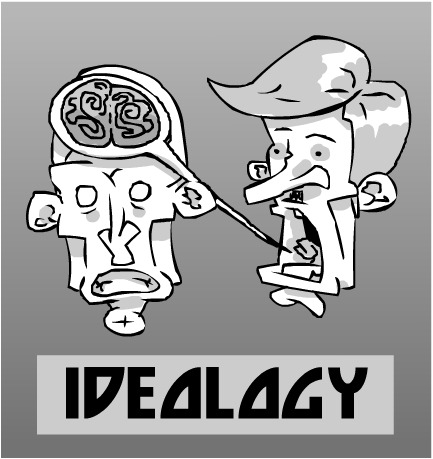
(Image retrieved from: https://investigatemedia.wordpress.com/2013/10/09/functions-of-ideology-benefit-to-the-elite/)
The structures of society have seen much change over time, and yet very few people seem to stay socially woke to analyze, or let alone even think about, the structuring and restructuring that happens all around them, especially when it comes to one of the most essential things in life: one’s culture. While some manage to stay socially woke, most of society just go “That’s just the way things are,” to their life and the circumstances they’re in. But, thanks to Western theorizing, future generations (such as ours), are now more socially aware than ever. With many thanks to the work laid down by the likes of thinkers such Marx, Gramsci, Lukacs, Marcuse, Horkheimer, and Adorno, society can better understand the various facets to as to why these are our circumstances, why our culture is set and influenced and such, but most importantly, how we are dominated by our very culture.
One man who laid down the immensely thorough ground work on the class struggles created by the domineering control of the ruling class is Karl Marx. Marx’s work heavily influenced other great theorists and thinkers, and many other works soon followed his own.
Yet, even if Marx analyzed the working conditions and laments of the proletariat under the domineering control of the bourgeoisie and predicted that the proletariat’s class consciousness would later result in a socialist revolution, the socialist revolution never occurred.
Why? Because Capitalism smartened up. Thanks in part to the scathing critiques given by Marx on capitalism, a conscious development towards the experience and working conditions of the laborers was enacted to revamp their employment experience. The socialist revolution was prevented as capitalists managed to improve working conditions for the working class and through this, they survived “social, cultural, and economic crises.” As capitalism continued to develop, people began accepting it as the proper and rational way that things should be.
This social, cultural, and economic change enabled the class consciousness to be manipulated into accepting capitalism as an ideology; this was a stepping stone to furthering the control and domination of the working class. Marx’s work, and the resulting events that followed his critique on the social, cultural, and economic conditions of his time influenced Western theorists to come up with their own perceptions and work on the use of ideologies to produce domination and control over society.
These notable Western theorists are Gramsci, Lukacs, and those hailing from the Frankfurt School are Marcuse, Horkheimer, and Adorno, and they explored the ideas of hegemony, reification, and the use of science as a tool with which to dominate and control.
With Gramsci using hegemony as the term to refer to a certain situation where in the consent of the oppressed is obtained through the infusion of an ideology into a society to make them easier to control. Meanwhile, Lukacs gave us reification which, when translated from its German descent, literally means objectification. This objectification means that the nature of social relations has been transformed into one that resembles relationships between traded objects.
Their work connects with those done by the Frankfurt School theorists which “conceptualizes domination as an internalized and potent form of reification,” (Contreras, 2017).
The creation of these ideologies stemming from the way that Marx first observed the use of an ideology as a weaponized tool for domination have greatly paved the way for the knowledge we have now. This knowledge reminds us of the dangers of ideology. Everything around us is either a product of our culture, or one of the things that dictates and creates that very culture of domination and control.
This lesson in theoretical antecedents is more than the theories of these dead white men, this lesson reminds us that one of the main dangers of ideologies is getting so caught up and dragged into one that we accept it without further thought. To be a critical citizen is not just knowing current events, but it also lies in dissecting the cultural structures around us and asking “Do I have the control? Am I the subject, or the object today?”
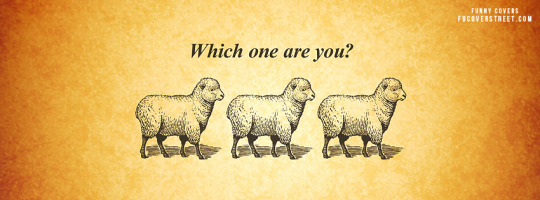
(Image retrieved from: http://fbcoverstreet.com/facebook-covers/brainwashed)
Understanding theoretical antecedents and the theories of these dead white men means that we train ourselves to fully understand what they mean when these dead white men speak about domination through ideology. Stay vigilant friends, and accept nothing without first questioning, lest we join the asinine majority.
0 notes
Text
The New Platform for the Political
(Reposted due to loss of first blog)
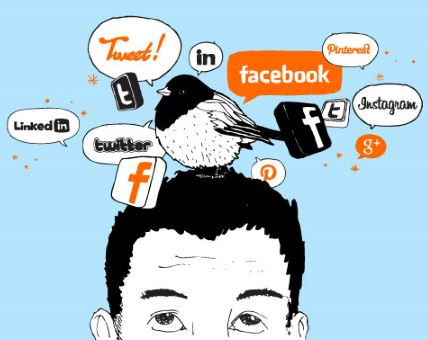
(Retrieved from: http://antikleidi.com/category/%CE%B1%CF%86%CE%B9%CE%B5%CF%81%CF%8E%CE%BC%CE%B1%CF%84%CE%B1/) The modern digital age is here my friends, and with it it brings a rising tide of technological advancements once thought impossible, and millions of platforms where one can openly share their thoughts, ideas, pictures, even what they had for lunch. The modern digital age has enabled the creation of the collective network we know as “social media,” and as a millennial, it has become a daily part of our lives. But what about the people who only decided to join these social media platforms not too long ago? What about those who, until the unlimited internet promos and free facebook data were made available, had previously little to no access to these platforms? Since things like unlimited internet surfing and free facebook data promotions have been made available by our service providers, the world is suddenly a much bigger place, with everyone giving their input on everything that they can. Now that virtually almost everyone has a connection and way into these platforms, the way we see the world, and the different phenomena and events in it, have changed drastically.
Social media has allowed anyone and everyone access to voice out their thoughts and greatly influence the thoughts and decisions of others reading their posts. Nowadays, we have people who are called “social media influencers,” whose very job is to promote various things on their social media accounts, whether it be products, or their thoughts on a certain subject matter. A few years ago such a job didn’t even exist, and now it could be a main source of income and may open up new opportunities for those who decide to go in that livelihood direction.
The widespread and daily use of social media has also created something else. While it is a platform to share your daily activities, whether exciting or mundane, or to get your new “fire” mixtape out, this shared space has created a new platform for the political.
With people being allowed to voice out their own opinions and thoughts, social media is undoubtedly a great place to give your own two cents about political phenomena. Yet, this is no longer reserved for those who are actually in the field of study anymore; anyone (and everyone) ends up giving their opinions, sometimes exceptionally strongly-worded opinions, on the current events within our political landscape. The positive side to this is that everyone is engaged in political conversation: political scientists are able to speak to a much wider audience regarding several important subjects matters; information that enables us to make appropriate decisions is readily available; candidates have a better platform to properly introduce their agendas; and we are able to engage in discourse with intellectuals.
But, as with every positive, there is always a negative side. The opening up of such political platforms for people to engage in discourse has enabled the rise of political trolls, who, when engaged in proper discourse, merely reply with “putang ina mo,” or “bayaran ka lang.” Along with these trolls came the ginormous headaches of fake news, lies spread and propagated with the aim of defamation of character, resulting instead to attack the person rather than their argument. The rise of political trolls and their widespread reach has, sadly, influenced a lot of people towards the wrong schools of thought or decisions.
However, the rise of social media must be accepted, for the digital age is here to stay, and it will only transform even further. The creation of these social media platforms means that history is no longer written by the victorious, for even the downtrodden and the minorities may write about the various events and phenomena that occur throughout the globe, political or otherwise.
With the opening of this new political platform through social media, politics as we know it has transformed as well.
0 notes
Text
A short reflection from today’s lesson on Theoretical Antecedents (June 5, 2017)
(Reposted due to loss of first blog)
In the very first lesson of Political Theory 1, our professor told us that we would be closely examining and studying the theories made by “dead white men” and that these theories are some of the critical foundations to political science. This would undoubtedly hold to be true as the work created by these dead white men were reflections of the political arena that they lived and *figuratively* fought in. Their basic concepts of their work have laid foundations and theories for other political scientists to conquer their own political arenas and contribute to the academe that we now proudly try to survive.
Now, in Political Theory 2, these dead white men are back with more to teach. In today’s lesson, the concept of Theoretical Antecedents was tackled, and this was an overwhelming lesson in the sense that it was dynamic. The possession of the people of the Dialectics of Enlightenment (where in Popular Culture, Total Administration, One-Dimensional, and High-Art was discussed) as tools and influences that assisted the formation and structure of the major ideologies we see today in the Philippines.
As these dead white men were back, so were their theories. Amongst these dead white men that made a comeback from Political Theory 1 was Karl Marx. His theories (and the ones that followed, inspired by his work) are distinct as they dealt with social revolutions, and as continuations of his work, thus followed the Frankfurt School, Western Marxism, and Gramsci. In addition to this, we also discussed how colonization (something very relevant given our long and arduous history of colonization) could reshape and reform people’s outlook in an ideology, or a country.
All in all, the theories that we discussed today have greatly structured and further restructured people’s differing outlooks on the creation of a proficient society that could further grasp and utilize the Theoretical Antecedents in the lives we lead today.
1 note
·
View note
Text
The Other Side
(Reposted due to loss of first blog)
As I was in my elective literature class, my professor was droning on about something that I could barely remember now. I was staring off into space and suddenly, something she asked brought me back to focus. She asked “Who are you? Who are you really? Can you tell me, right now without a shadow of a doubt, about who you really are?” After this, she left the class a few minutes of silence to ponder about this question. The faces around me seemed sure enough, yet as the time waded on, I looked around again to see scrunched up foreheads, eyes brought back to the reality of wondering who they really were.

When I thought about this question I was utterly sure of my answers. I’m Angela Torres, id number 11338741, a political science major in DLSU, I’m a cheerleader from the DLSU Animo Squad and Team Pilipinas and..... Well after that the rest was prone to uncertainty. I was certain I liked some kinds of foods, but only on given times, I was certain I was in a relationship, but uncertain about how long it would last, and if I was dating the right gender. I was certain of my social standing and political views, but even that was subject to change. I was not certain at all about my religious views as going into that discussion could leave me stuck in that chair for hours with a scrunched up forehead caught in a conflicting discussion of morality, existence, and rage at the inconsistencies of the institutions of the dominant faith in the country.
My professor had made a point; I could not, without a shadow of a doubt, really tell her who I was. I started thinking if I really had a say in the matter, or if I was shaped by my environment, formed by the influences of my peers, configured by the likes and dislikes of those around me. Was I really an individual, or an individual just part of a larger group, a class cultivated in the upper legions of the society? All these things rushed through my head in a few minutes and boy, it was overwhelming.
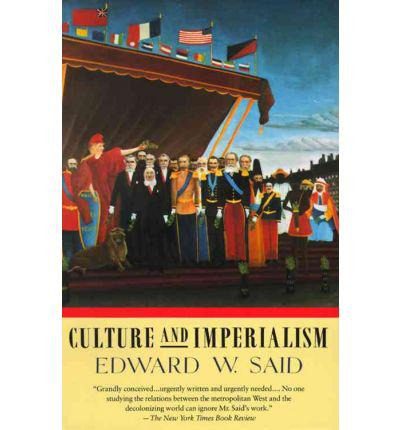
(Image taken from: https://www.google.com.ph/search?q=culture+and+imperialism&source=lnms&tbm=isch&sa=X&ved=0ahUKEwi5mpbejKzVAhUBnpQKHayJCNIQ_AUICigB&biw=1366&bih=623#imgrc=vwGsYO3YThGxqM:) The reason that we were discussing the issue of our individual identities was due to our analysis on the book Culture and Imperialism by Edward Said. When I first read it at home I got the same reaction that any undergraduate that does not major in literature got: “wat.” But as our professor began to delve and dissect his work further in class, the more I understood the depths that culture and one’s environment has on their identity. In the book, Said writes
“No one today is purely one thing. Labels like Indian, or woman, or Muslim, or American are not more than starting-points, which if followed into actual experience for only a moment are quickly left behind. Imperialism consolidated the mixture of cultures and identities on a global scale. But its worst and most paradoxical gift was to allow people to believe that they were only, mainly, exclusively, white, or Black, or Western, or Oriental. Yet just as human beings make their own history, they also make their cultures and ethnic identities. No one can deny the persisting continuities of long traditions, sustained habitations, national languages, and cultural geographies, but there seems no reason except fear and prejudice to keep insisting on their separation and distinctiveness, as if that was all human life was about. Survival in fact is about the connections between things; in Eliot’s phrase, reality cannot be deprived of the “other echoes [that] inhabit the garden.” It is more rewarding - and more difficult - to think concretely and sympathetically, contrapuntally, about others than only about “us.” But this also means not trying to rule others, not trying to classify them or put them in hierarchies, above all, not constantly reiterating how “our” culture or country is number one (or not number one, for that matter).”
As our professor analyzed this piece of text further, she mentioned something that will stick with me forever. Once we are born, we enter a social contract (and I thought, okay yes, this is true, much like the varying social contracts we discussed in Political Theory 1). But, this social contract is to keep us from being “the other.” She further explained that this compulsory social contract is done through the things we do everyday: our acceptance of our initial gender from birth, our entrance into the religion our parents chose, our attendance in school to learn the language that we use to communicate with others in society, but the one thing that binds us to this social contract is our compliance and recognition of those in power. In acknowledging who holds power, those who are seen as authoritative figures, we begin to be accepted into identity classes, and the aspects of our identity are both ascribed (our sex, our familial bonds with others) and achieved (social status, political views). She mentions that we give up our freedom of identity in entering this social contract because in complying with this contract, we lessen the chance of become “the other.” The other is seen as the different minorities in society, those who counter the dominant norm.
Why did this stick with me? Because this was the first time I had been aware of the social contract that I had been complying to my entire life. In millennial terms, I had just become socially woke.
Now because I was aware of this different kind of social contract (as others were about safety and protection from the government as they were included in the territory covered by their sovereign, this kind of social contract was about social acceptance), it then begs the question: who is my other? Specifically, I want to answer this question specifically in relation to gender. After all, I’m straight, and while I have been experimental, it’s not something I’ve been loud about since I’ve never had a girlfriend and I’ve never been serious about “girl crushes.” I’m in a great heterosexual relationship and have never faced any backlash for my choice in a partner because my gender choice and sexuality is the dominant one. In this context, I acknowledge my other as those in the LGBTQ+ community with different genders and sexualities.
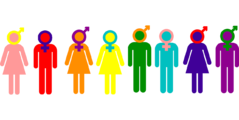
(Image taken from: https://www.google.com.ph/search?q=lgbtq&source=lnms&tbm=isch&sa=X&ved=0ahUKEwj54peMjqzVAhVGKZQKHcawAWcQ_AUICigB&biw=1366&bih=623#imgrc=VOZp6_a4VVKf5M:) Despite growing up in a religious family with a conservative ideology, I’ve never been homophobic, nor have I ever thought that that kind of relationship and gender choice is wrong. Perhaps it’s because I’ve been exposed to people in the LGBTQ+ community from a young age and have continued to be exposed to it (I have a gay uncle, some of our household helpers are gay, my friends from high school have come out to me). I’ve always thought that it was their choice, and if they were happy and not hurting anyone, who was I to say otherwise, right? But, as that kind of relationship and gender choice was not the norm, it’s sad to say that not everyone views it the way I do. The LGBTQ+ community has had a long history of violence, domination, and marginalization. They’ve been through a grueling road to have the rights they have now, and presently, there’s still a lot to be done. And now we have to ask, how has their identity, their very community of shared identities been marginalized and dominated, especially in the Philippines?
Because the Catholic Church is such a strong socialization agent in a country that is dominantly Catholic, their power and influence is both significant and massive. By having this religion as part of the regular Filipino’s identity, their identity is heavily constructed by the power relations that occur within a dominantly Catholic society. And, in the eyes of the Catholic faith, homosexuality is a sin, and their denouncement of all homosexual acts and those who partake in this lifestyle and personality are automatic sinners, thus making those in the LGBTQ+ community the other.
Through this othering, the LGBTQ+ community has become an object of domination and marginalization on the basis of their gender and sexuality. They have been outwardly subordinated, persecuted, and oppressed by some of the very people who preach every Sunday about loving and forgiving everyone.
Members of the LGBTQ+ community have been subordinated, persecuted, and oppressed by the very labelling of their identity as the other in our society. They are the social deviants of the norm that was established as strictly heterosexual relationships. Their rights to marriage (or even civil union) have been put on the backburner of social issues and have been denied to them. The basic right of expressing their love through lawful ways so that they can share in the rights that married couples do has been denied many times over. The very nature of their relationship has been sullied and dragged through the dirt, one senator (who is overtly religious) goes as far to say that members of the LGBTQ+ community are “worse than animals.” They have faced homophobic slurs, people showing up at their LGBTQ+ Pride walks with signs saying that they’ll go to hell, they’ve faced defamation of character because some people can’t recognize other aspects of their identity, merely stuck on their gender choice. These people have experienced being disowned by and disconnected from their families because of who love. They’ve undergone severe persecution for a feeling they have no control over, an love they cannot deny.

(Image taken from: https://www.google.com.ph/search?q=gay+pride+protest+signs+philippines&source=lnms&tbm=isch&sa=X&ved=0ahUKEwj1ioLdnqzVAhUCmJQKHR0FDGcQ_AUICigB&biw=1366&bih=667#imgrc=Ca6ysK03IKk3gM:)
But, despite all of the subordination, persecution, and oppression, the LGBTQ+ community stays positive, they help out their other members in expressing and staying true to their identity, they’re encouraging and help guide and support each other. In the midst of the marginalization of their shared identity and culture, they stand together, resistant to the powerful dominant ideology of this nation in the hope that one day, they’ll get people in power to recognize their identity as one that should not be marginzalized nor feared.
0 notes
Text
Who holds the power?
(Reposted due to loss of first blog)
Long ago, in ancient Greece, there lived a man named Pittacus. Pittacus was an ancient Mytilenaen military general and was widely known for his wise use of the power he was given to valiantly lead his men in the battle against the Athenians. When talking about power, it is prudent to remember what Pittacus has to say about it; according to PIttacus,
“The measure of a man is what he does with power.” This conveys that power is something that every human wields in their life. While the amount of power that each of us hold differ in great amounts from social class to social class, there is no denying that each individual holds power in some form or another. As Pittacus says, one may be measured by what one does with this power, how one wields it, and how one uses it to help or hurt both themselves and their fellow humankind. Thus, to conduct a power analysis on a micro level would greatly help to further inspect how one might use their power, and how this power is transferred, shared, or utilized amongst a group to increase each one’s power and how this power is used for the gaining of resources. To analyze this, I’ve created a visual representation to better illustrate the way power is allocated on a micro level, or in other words, in my household. The following tables are representations of the breakdown of power allocations:
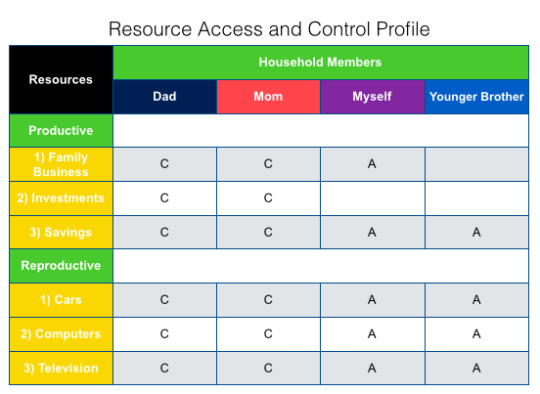
For the resource-access and control, it’s clearly shown that my parents have full control over all aspects of both our productive and reproductive resources. As their children, my little brother and I have access to the resources that they enjoy, allowing us to enjoy them as well. But, while we have access, my little brother and I do not have complete access to all resources that our parents handle.
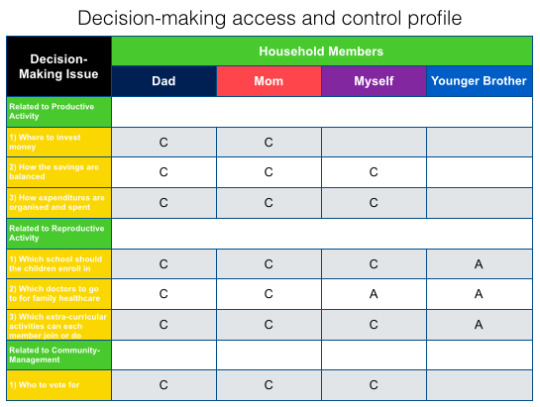
Next, this table represents the power each of the members in our immediate family has when it comes to making decisions about a variety of productive and reproductive issues such as where to invest, how expenditures are organized, what schools should we be sent to. Again, my parents have the ultimate power as they clearly have control over the power of decision-making and get “the last say.”

Following that is the benefits and burdens table. This displays the benefits and burdens that my little brother and I receive from our parents. But, in this table, our house helpers and drivers are added as they receive benefits and burdens from my parents as well. The burden of keeping our household maintained is shared amongst all members of our household, whether they are in the immediate family or not. As for the benefits, our household helpers and drivers receive income for their work, so they have access to this as well.
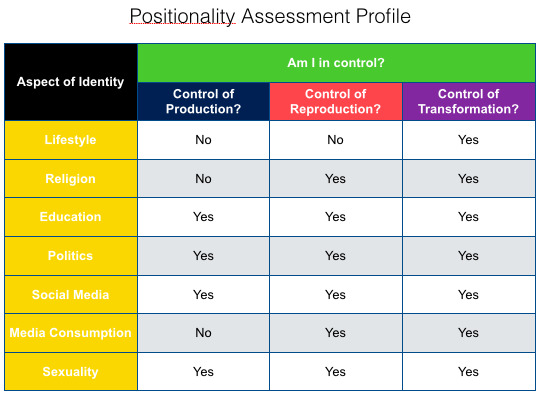
Lastly, my positionality assessment profile. For someone my age (21 years old), I have a good amount of freedom when it comes to the most personal and important aspects that shape my identity. Aspects such as my religion, sexuality, and politics is something I enjoy freedom of choice in. While my parents are quite religious, they do understand the importance of letting their children choose their own paths, thus I’ve grown up to have quite a liberal identity. All in all, our household is like any Filipino household as my parents hold total control over decision-making and our resources, which is to be expected as they are the sole providers of the family. Yet, while they hold total control and absolute power, they allow us, their children, to enjoy some benefits, as well as access to decision-making. Also, since power operates through ideology and the ideological institutions behind it, one can clearly see through the tables that the ideological institution of religion and mass media has great affect on how power operates in our family. Being a dominantly religious country, Filipino families are expected to be highly patriarchal in nature. Fathers are seen as providers, while mothers are homemakers and caretakers of the familial household. Yet, thanks to the operationalization of power through the ideological institution of mass media, our family enjoys a more liberated reality from that of the strictly religious expectations of a the common Filipino household. This freedom differentiates us from utterly strict households where children have little to no power over decisions that directly or indirectly affect them, and for this shared power from my parents, I am truly grateful. It is also important to note that while I grew up in a traditional, and a dash of liberal, household, my parents have given me the power to choose for myself. This power I’ve wielded for years has allowed me to form the identity I have today, and I’m sure it will allow me to further better this identity. I will note, of course, what PIttacus has said that the measure of an individual is what he does with power, and with the power I’ve been given, I hope that the identity I end up shaping lives up to the great measure of what an individual truly should be in this world.
0 notes
Text
Critical Essay 1: An Analysis on the Cultural Commodification at play in Cambodia and Vietnam
Ever since I was a little kid, I’ve always found any field trip exciting, whether it was to see a farm or a trip to the National Museum. Yet, in all the field trips I’ve had in the past, none have explored a concept so rich in depth and so entangled in historical and political violence: that of cultural commodification. Upon learning that several sections were going to Vietnam and Cambodia (both countries that have experienced lengthy histories of political violence, and just plain ruthless violence), I was excited. Not only to go to new countries which I have never explored before, but to be there to experience their history and culture from a different perspective. I was going there to learn about their tragic pasts, and most importantly, analyze how this past has had a bearing on shaping who they’ve become and how this has shaped their collective identity as a nation.
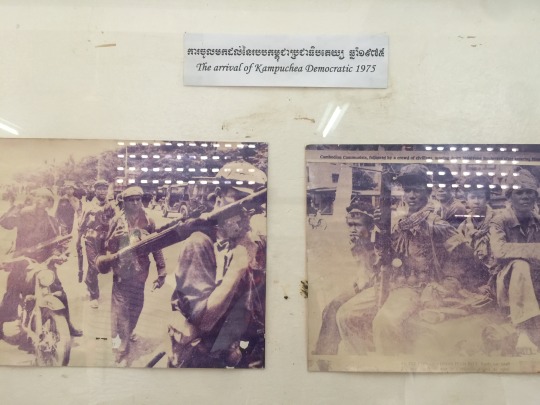
Our first stop that would enable our class to better analyze the cultural commodification of their history and culture was the Toul Sleng Prison located in Cambodia. The prison was not a long way away from our hotel, a mere 15 minutes at maximum. This brought me to my first thought regarding their cultural commodification: A place that used to hold so much pain and torment was now surrounded by various hostels, small stores, and other small businesses as the prison is now a tourist hot spot. Once inside the prison, our tour guide educated us on the history of the area, saying that it was once a prison. As he finished his lecture, he mentioned that there were only 4 survivors from this prison, and two of them were in the very prison-turned-museum itself, sharing their story of horror and violence. This was what really shocked our whole class, because our guide just finished explaining the horrors of the past that occurred in the prison, and yet here was a man who had underwent some of the severest torture methods known to man kind, and he was willing to speak about it, to relive it again and again. But, we’ll get to him later.


As we explored the various buildings of the museum, an overwhelming sense of quiet sadness filled me. These buildings were not recreations. I walked on the very steps that dead men have gone through. I explored the rooms where humans have lost their humanity in exchange for their strong belief and devotion in their ideology: the Communist Party of Kampuchea. These hallowed halls that are now quiet once held the muffled screams and various scenes of human mutilations that I could only think of in the darkest parts of my head. These buildings have seen the mass takings of human lives, and more importantly, they’ve seen the dehumanization of beings that were willing to cause these horrific mutilations, all in the name of their beloved ideology. As each building contained rooms and rooms filled with the faces of men, women, and even children, that have miserably passed through those halls, the walk through each room became more solemn. Here were their dead men, women, and children. Here were the faces of humans who lost their humanity. Here were their clothes, piled on top of each other and simply stored in a cabinet. Here were the faces of the soldiers and torturers who were so moved by their ideology that they were willing to do all these things to their fellow humankind. And there we were. There we were paying for the chance to see the horrors. There we were paying for the chance to relive some of the most painful pasts. Ladies and gentlemen, I present to you the cultural commodification of the historical horror of Cambodia.
This cultural commodification has greatly shaped their identity since “it is widely common for destinations to use the aspect of culture as a means to attract tourists. This means making culture a commodity and hence packaging and selling it for consumption,” (Cole, 2007).
0 notes